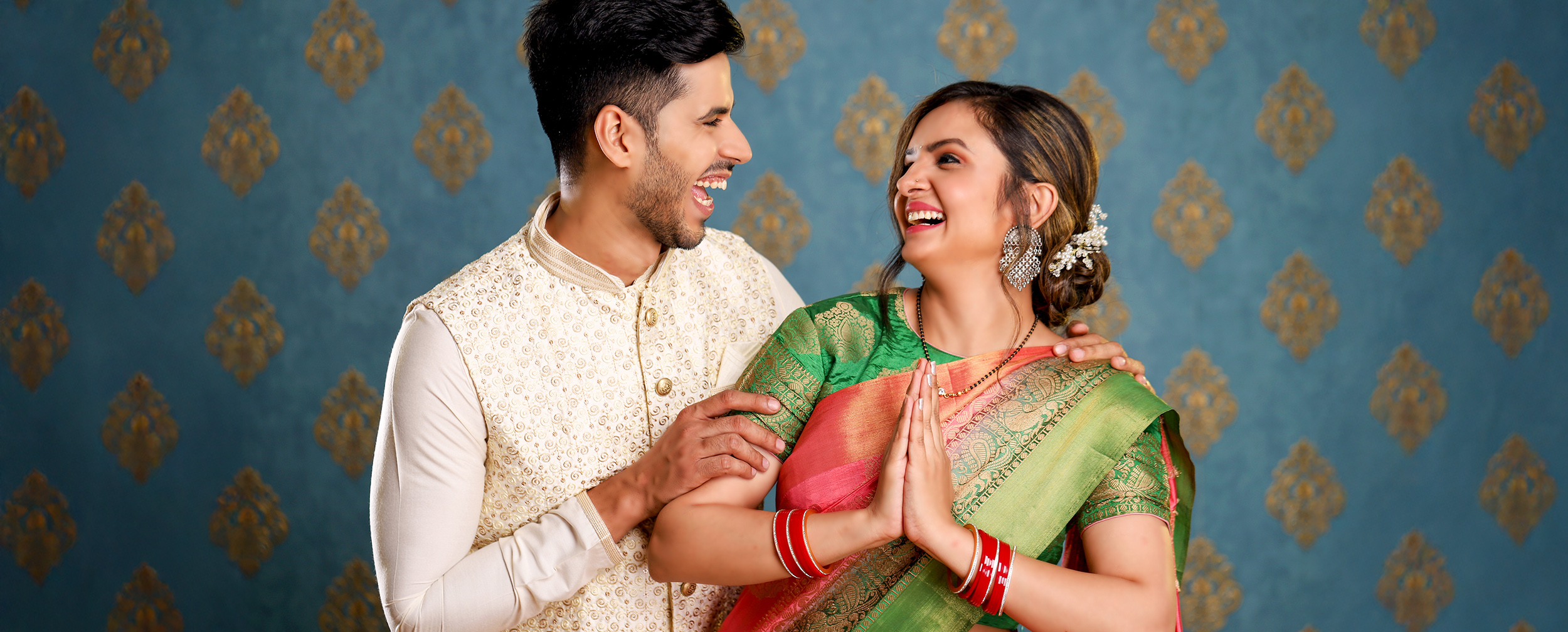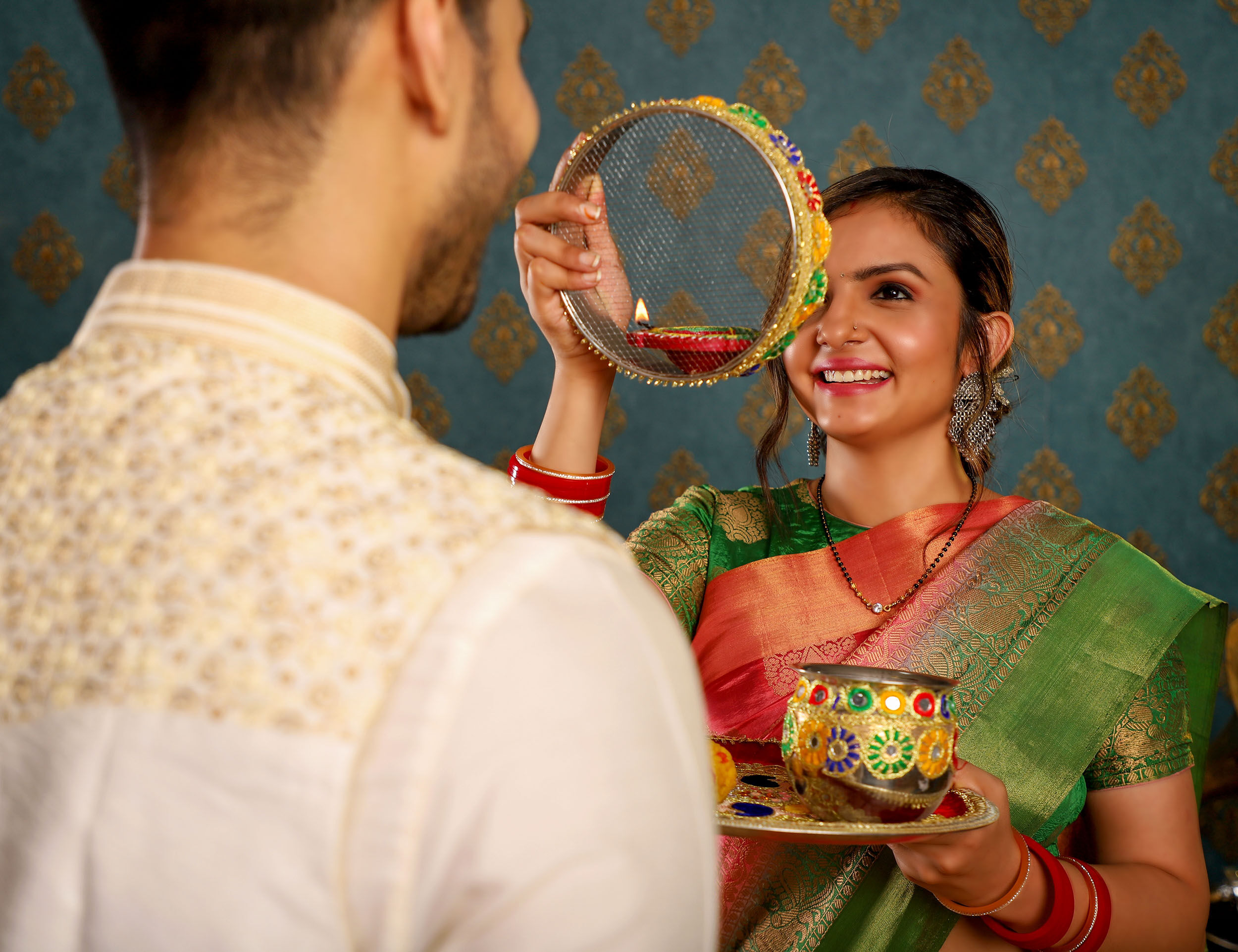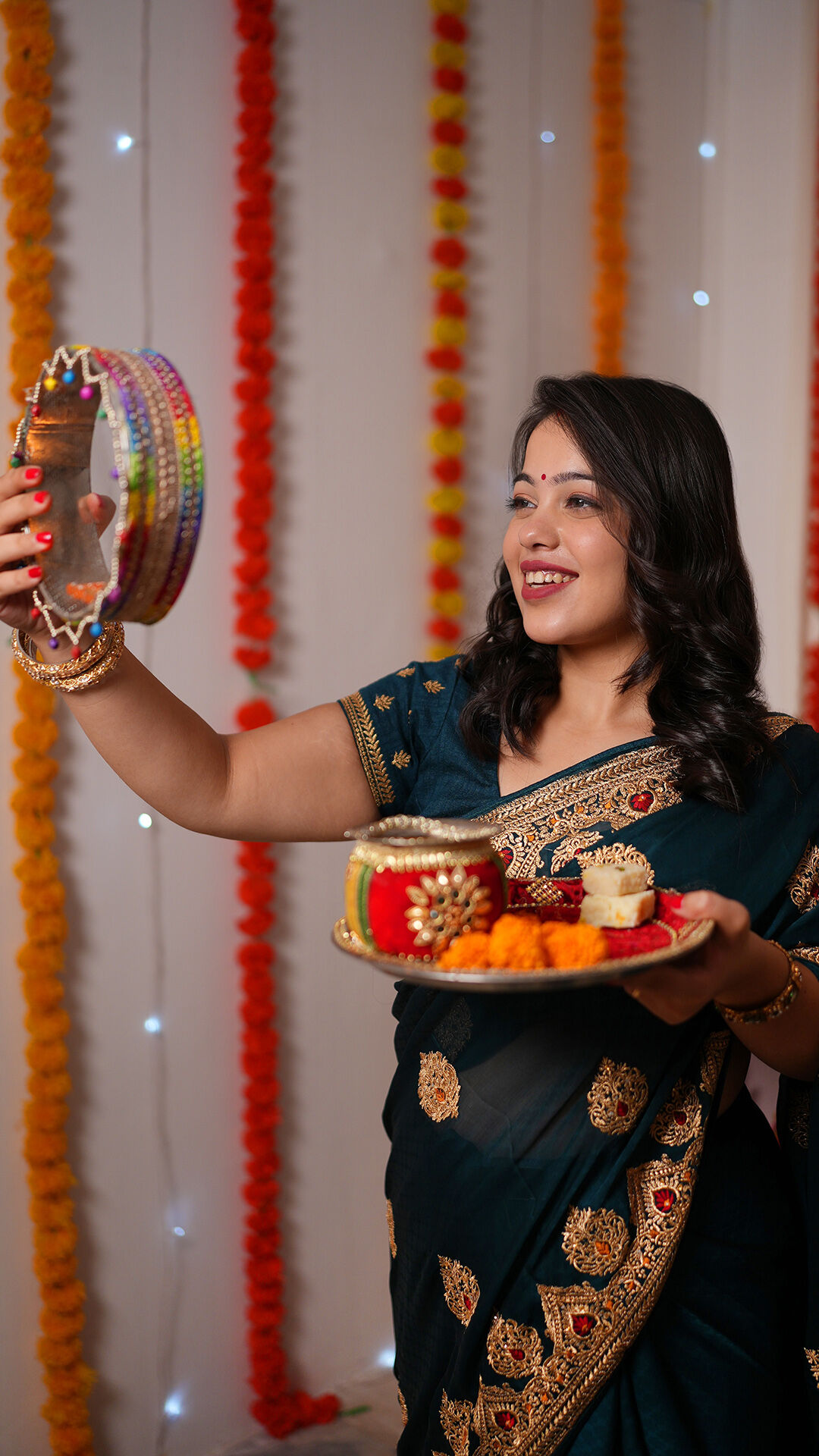STORIES BY MANYAVAR & MOHEY

Lifestyle
Karwa Chauth 2025: Legends, Rituals & Meaning Behind the Sacred Fast
Date 24 September 2025 Reading time: 7-10 mins
From sunrise to moonrise, millions of women across India turn an ordinary October day into one of devotion and love. Why Karwa Chauth is celebrated goes beyond fasting—it is a cultural tradition that blends mythology, ritual, and modern expressions of affection.
Whether you’re a bride preparing for your first fast or simply curious, Karwa Chauth carries meanings that connect generations of women and families. Let’s uncover its stories, rituals, and enduring relevance.
What is Karwa Chauth?
The fourth day after the full moon in the Kartik month marks this unique fast. In which state is Karwa Chauth celebrated? While Punjab, Haryana, Rajasthan, and Uttar Pradesh lead, the tradition now spans across India and beyond. Karwa means the earthen pot used in prayers, and Chauth means the fourth day.
Women begin before dawn with sargi, a meal gifted by mothers-in-law, then observe a strict nirjala vrat (fast without food or water) until the moon rises. Considered one of the toughest fasts, it is still embraced with devotion.
Importance for Married Women
The spiritual significance of Karwa Chauth goes deeper than ritual—it symbolises renewing wedding vows, praying for family wellbeing, and sharing sisterhood with other women fasting together.
For first-time observers, the day often feels like a rite of passage—nervous yet joyous—as they step into their role as wives within the family.
History of Karwa Chauth: Mythological Roots
The story behind Karwa Chauth dates back over 2,500 years. Ancient traditions linked it to Shiva and Parvati, lunar worship, harvest thanksgiving, and wives praying for warrior husbands. Over centuries, these customs merged, shaping the festival we know today—centered on devotion, protection, and marital bonds.
Legends of Karwa Chauth
Sacred stories explain why Karwa Chauth is celebrated with such sincerity. Each tale holds lessons of love, courage, and resilience.
Queen Veervati's Devotion
One of the most famous stories behind Karwa Chauth is about Queen Veervati, whose journey highlights patience and faith. On her first fast, Queen Veervati’s brothers tricked her into breaking it early. Soon after, her husband died. Heartbroken, she prayed all night, and the gods restored his life—showing that devotion and faith can overcome tragedy.
Karwa's Love and Prayer
Another powerful narrative explaining why Karwa Chauth is celebrated features a brave woman named Karwa. When her husband was attacked by a crocodile while bathing in the river, she acted with courage and devotion. The God of death spared him and blessed her, symbolising strength and love. The karwa pot used in rituals echoes this power of faith.
Draupadi's Fast in Mahabharata
The Mahabharata provides another layer to understanding why Karwa Chauth is celebrated. Draupadi observed fasts for the well-being of the Pandavas, even during their exile.
Despite challenges, she stayed committed to her vows, showing how fasting can be a source of strength. For her, it wasn’t just about a custom but about focus, resilience, and faith — ideas that continue to inspire many women today.
How to Celebrate Karwa Chauth: Traditional Practices
Understanding how to celebrate Karwa Chauth requires appreciating the intricate rituals that transform an ordinary day into sacred time.
Pre-Fasting Rituals
Karwa Chauth celebrations often begin a day earlier with mehendi sessions. Women choose festive outfits in shades of red, pink, or maroon, decorate the karwa (earthen pot), buy fresh flowers, and prepare puja essentials.
The day starts with sargi, the pre-dawn meal, usually including pheni or sevaiyan (vermicelli in milk), fruits, savoury snacks like mathri, nuts, and a glass of milk or lassi. Modern spreads may add dates or energy bars, but the essence remains nourishment as a blessing.
The Daylong Fast & Prayers
As dawn breaks, the significance of Karwa Chauth unfolds through disciplined abstinence. The day begins early, with morning routines, light household tasks, and a quiet moment for prayer or meditation.
The afternoon is usually slower, filled with rest, family bonding through stories, and preparing puja essentials before dressing up in festive attire. As evening approaches, the focus shifts to final puja arrangements, gathering with other women, listening to Karwa Chauth stories, and finally waiting together for the moon to rise.
Breaking the Fast at Moonrise
The moment everyone awaits arrives when the moon peeks through clouds or buildings. Celebrating Karwa Chauth culminates in these carefully orchestrated steps:
- Moon Sighting: Women carry their puja thalis to terraces or open spaces
- Sieve Ritual: Looking at the moon through a sieve or dupatta
- Water Offering: Pouring water (arghya) towards the moon
- Husband's Darshan: Viewing the husband's face through the same sieve
- Fast Breaking: The husband offers the first sip of water
- Sweet Moment: Following water with something sweet, often a piece of mithai
Modern Symbolism
Contemporary interpretations of why Karwa Chauth is celebrated reflect changing social dynamics while preserving core values. The festival adapts to new realities without losing its essential spirit.
Love and Commitment
Today's interpretation of Karwa Chauth celebrations extends beyond religious duty to become India's own expression of Valentine's Day—but with deeper roots. It celebrates mutual respect, joy, and romance. Social media shines with selfies, mehendi shots, and moon captures.
Strengthening Marital Bond
The spiritual significance of Karwa Chauth in modern times focuses on emotional connection rather than mere ritual compliance. Couples use the day to reflect on their journey, express gratitude, reset priorities, and create new shared memories.
Participation by Husbands
Perhaps the most significant evolution in celebrating Karwa Chauth involves increasing male participation. Husbands often fast too, surprise their wives with sargi or gifts, and share household responsibilities—making the festival a partnership of equals.
Regional Variations
The diversity of India shines through different interpretations of why Karwa Chauth is celebrated across states and communities.
North Indian Customs
Karwa Chauth is celebrated in which state with maximum fervour? Punjab leads with elaborate community gatherings where women dress like new brides, sing giddha songs, exchange decorated karwas, and share festive meals after moonrise. In Haryana, the day is marked with homemade sweets like gajar ka halwa, colourful rangolis, group katha readings, and sisterly gift exchanges.
Rajasthan adds its charm with puja thalis adorned with lac bangles, silver heirloom jewellery, and the sweet ghewar. In Uttar Pradesh, women often repeat their bridal looks with full solah shringar, prepare savouries like matthri and shakarpara, and gather at temples for evening prayers.
Similar Festivals (Teej, Vat Savitri)
Understanding why Karwa Chauth is celebrated becomes clearer when compared with similar observances. It often gets compared with festivals like Teej and Vat Savitri, which share themes of devotion and tradition. Teej, celebrated in the monsoon month of Shravan (July–August), is all about rejuvenation — and unlike Karwa Chauth, even unmarried girls take part.
Vat Savitri Vrat, observed in Jyeshtha (May–June), centres on worshipping the banyan tree and draws inspiration from the legend of Savitri and Satyavan. It’s especially popular in Maharashtra and Karnataka, where women pray for their husband’s well-being under the sacred tree.
Emotional & Spiritual Significance of Karwa Chauth
The spiritual significance of Karwa Chauth encompasses multiple dimensions. Women see it as a way to practice self-control, build mental resilience, dedicate sacred time to prayer, and connect with divine feminine energy.
Emotionally, the day strengthens sister-like bonds, creates intergenerational connections, builds excitement in marriages, and helps families establish lasting traditions. Many women even describe a special “Karwa Chauth high”—a mix of accomplishment and spiritual upliftment after completing the fast.
Enduring Relevance Today
Despite modern schedules, the festival thrives. Women balance office hours with mini gatherings, connect over video calls, and shop online for sargi hampers and festive outfits.
Its meaning has also grown—husbands join in, couples celebrate equality, and families cherish the shared bonding. In many ways, Karwa Chauth has become a bridge between generations—rooted in tradition yet beautifully relevant today.
Where Faith, Love, and Customs Endure
Karwa Chauth's endurance lies in its ability to evolve while preserving its soul—uniting couples, strengthening families, and reminding us of the power of faith and commitment.
Whether Karwa Chauth is celebrated with elaborate customs or adapted to contemporary lifestyles, it remains a cherished expression of love and togetherness.
And as every woman adorns herself in solah shringar, the right outfit adds grace to the occasion. With Mohey’s exquisite collection of festive wear, each moment feels even more special.







